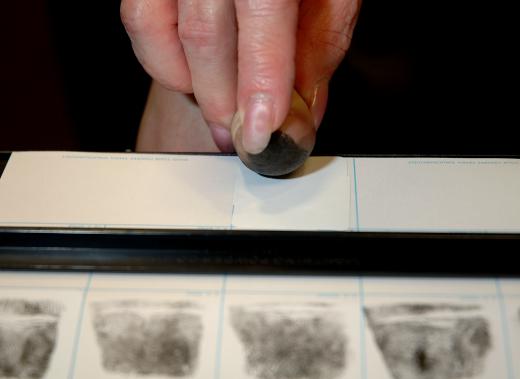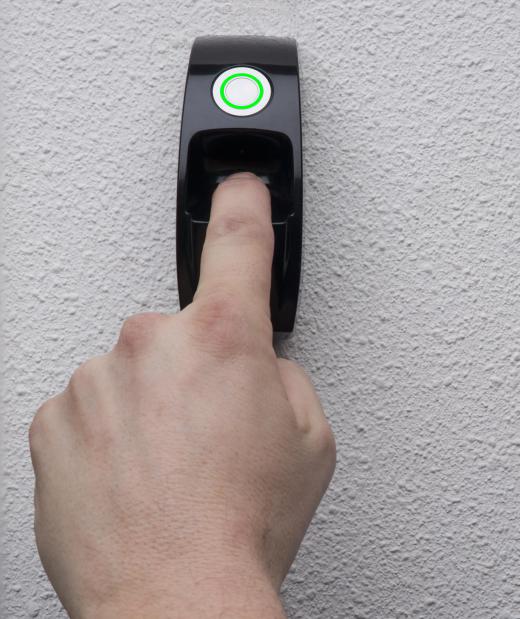What is Biometric Data?
Biometric data refers to records used to uniquely identify people, such as fingerprints. Biometrics is the name given to the various methods of capturing, storing, and utilizing this data. Two major uses of biometrics include the identification of individuals for the purposes of controlling access, and various applications for tackling and preventing crime.
Characteristics that are used for biometrics authentication are often classified into two major categories, physiological and behavioral. Physiological biometric data relates to the physical aspects of a person’s body. These include items such as fingerprints, retinal scans, and facial scans. Behavioral biometrics, sometimes called behaviometrics, include signatures, handwriting analysis, and voice pattern recognition.

In determining what items of biometric data may be suitable for biometrics identification systems, a number of things are usually taken into consideration. The data item should be universal, that is to say that all people should possess the characteristic. It should be unique, so that an individual can be definitively recognized. It should be permanent, that is to say it should be a characteristic that does not change significantly as a person ages.

Another common consideration is the issue of how easy the data item is to collect. Taking a blood sample for DNA analysis, for example, is considerably more invasive and expensive than taking fingerprints. In addition, concerns about the efficiency and accuracy of the technology used to measure the biometric data may have an impact on the type of data that is chosen for a particular application.

Biometrics devices tend to operate in one of two main ways, verification or identification. In the verification mode, biometric technologies perform a single comparison of the presented data with a template that has been previously stored. An example of this is a fingerprint scanner on a personal computer or electronic safe. In the identification mode, a biometrics database is used. An individual item of data is then captured, and the system tries to match this piece of data with any of the existing items defined in the database. An example of identification biometrics is a fingerprint database of known criminals.

There are some concerns surrounding the area of biometrics technologies and the large-scale storage of biometric data. Opponents of biometrics may cite privacy concerns, for example that the data might later be used for purposes that an individual has not agreed to, or even that the information could potentially be stolen. Another issue that is sometimes raised is the concern that biometric data stores could be misused to discriminate against certain sectors of the population.
AS FEATURED ON:
AS FEATURED ON:















Discussion Comments
When I became licensed to buy and sell securities I had to have my fingerprints taken and kept on file.
I never had to use any kind of biometric fingerprint identification with my job, but this was kept on file with my background check and other personal information.
There are many jobs where this is a requirement. For the general public, it can be a little unsettling to think they need to take your fingerprint in order to complete a transaction for something.
I agree that we will probably see much more of this in the near future. They have been using biometric data in police work to help solve crimes for many years.
This is something that I believe is going to be seen at many places where we do business on a regular basis.
@SarahSon - I also have mixed feelings about companies using biometric data. With some organizations where they deal with highly sensitive information I can understand using a biometric security system.
There are advantages to the security and protection of the information they deal with. Other companies are probably looking at it as a way to help prevent identity theft of some kind.
I have a feeling we are going to start seeing more of this all the time. As technology advances and computers are used for just about everything, this is a field that is probably just on the verge of a lot of growth.
Our bank has a biometric fingerprint reader at each teller window. I don't know when they use this, as whenever I have completed a transaction, I have never had to use it.
Most of my transactions are done through the drive-up window, so I was surprised to see this the other day when I walked in the bank.
I don't remember them taking a sample of my fingerprints when I opened an account there. Maybe this is something they are going to be implementing in the future.
I'm not sure how I feel about the bank using my biometric data. If this is something they require to bank there, I think I would go somewhere else.
Post your comments